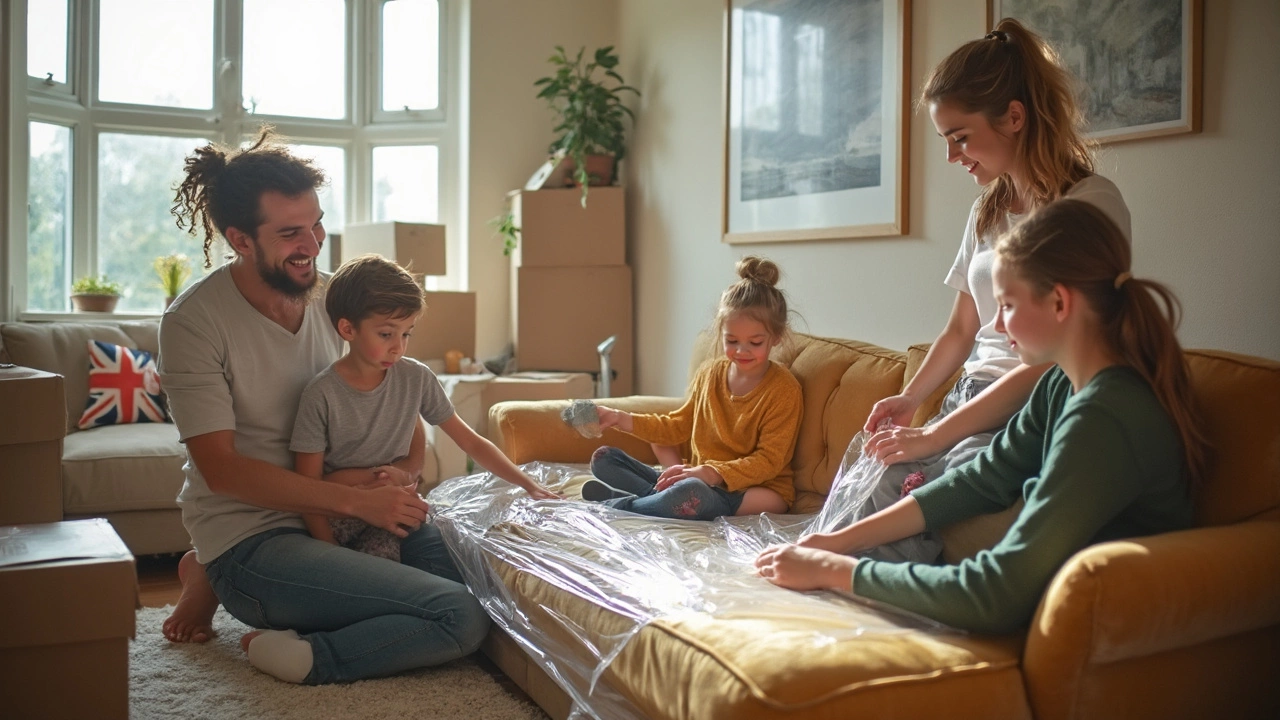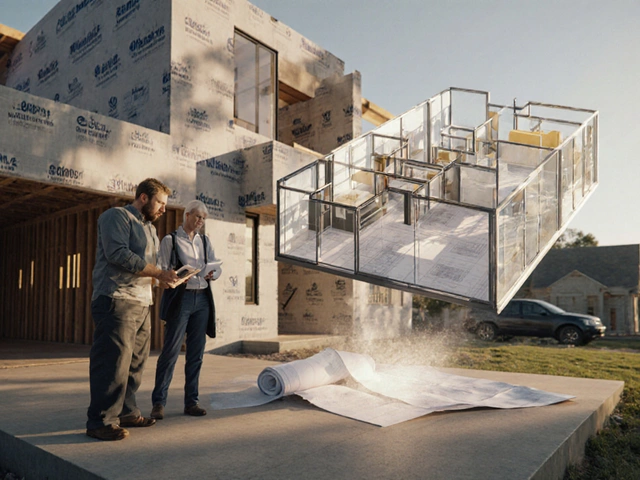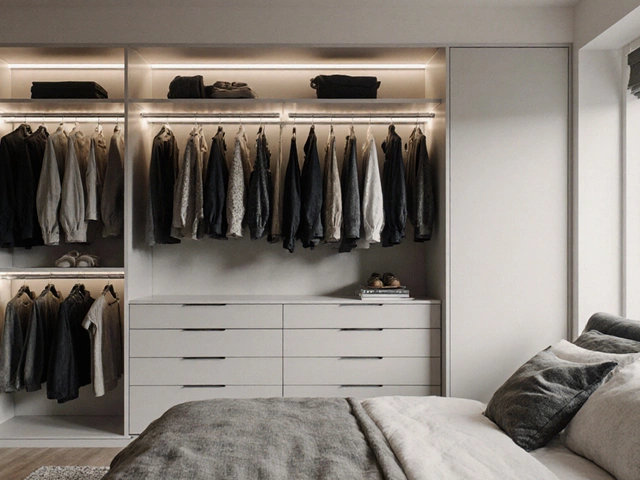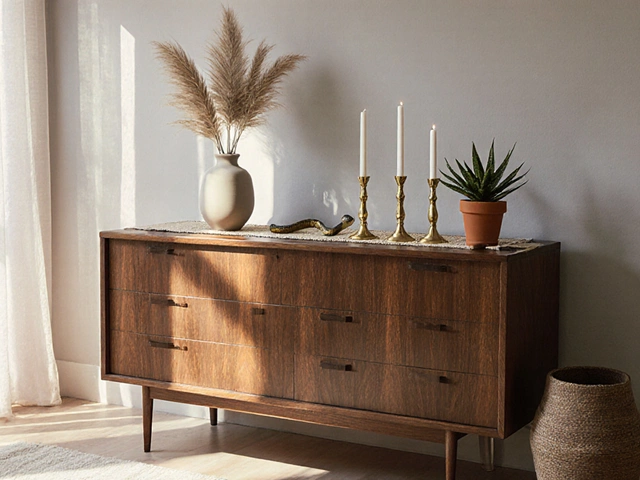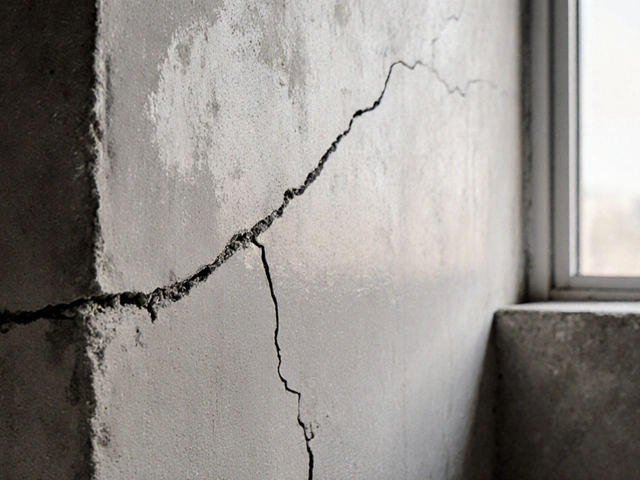Plastic wrap is everywhere when it's moving day or time to stash stuff in storage. On one hand, it's cheap and keeps dust off your furniture. On the other, you’ve probably heard horror stories about sticky residue, trapped moisture, and ruined finishes. So does plastic wrap actually damage furniture?
It depends on what you’re wrapping and how you do it. Wood and leather are way more sensitive than, say, a plastic chair. Trap in a little moisture and you might end up with clouded, warped, or moldy surfaces—especially if you're not planning to unwrap your stuff for months. And yeah, plastic on top of delicate paint or shiny wood can sometimes cause sticky nightmares.
The trick is to know when plastic wrap helps and when it just makes things worse. That’s what we’ll break down—plus, you’ll get solid tips on wrapping things the smart way, picking better alternatives, and keeping your favorites scratch-free (and not mildewy) while they’re packed away.
- The Basics: What Plastic Wrap Does
- Common Furniture Risks and Why They Matter
- Safe or Sorry: When Plastic Wrap Backfires
- How to Wrap Furniture the Right Way
- Alternatives to Plastic Wrap
- Smart Storage Tips for Zero Damage
The Basics: What Plastic Wrap Does
Plastic wrap is pretty much the go-to material when people think about moving or furniture storage. It clings tightly, stretches over odd shapes, and keeps out dust and dirt. The main job of plastic wrap is to create a barrier, but what’s it actually keeping out? Mostly moisture, dust, bugs, and scratches during a move or while stuff sits in a garage.
This stretchy wrap acts almost like a raincoat for your couch, chairs, or tables. It blocks spills and greasy hands. It’s also a champ at holding loose pieces—think couch cushions or dresser drawers—together so nothing tumbles out.
But, here’s where it gets tricky: wrapping furniture in plastic can also trap things you don’t want, like humidity. And if the wrap is too tight or left on too long, it might squeeze the finish or stick to certain materials. Especially for wood and leather furniture, letting air circulate is key if you want to avoid trouble.
Here’s a quick breakdown of what plastic wrap brings to the table:
- Protects against dust and dirt
- Shields from spills and surface scratches
- Keeps loose parts together
- Can help block bugs or pests (to an extent)
Some folks also use plastic wrap because it’s cheap and easy. A jumbo roll can cover a lot and you don’t need scissors to cut it—just rip and go. According to a recent survey of moving companies, about 80% use some kind of plastic wrap for furniture jobs. It’s quick and makes a visual difference; you know right away that something’s protected.
The flip side? It’s not magic. Plastic wrap doesn’t make furniture invincible, and in some situations, it might even cause issues you weren’t expecting—especially if you’re not careful about how you use it. In the next section, you’ll see exactly why that matters.
Common Furniture Risks and Why They Matter
When it comes to using plastic wrap during a move or for furniture storage, there are some common problems everyone should watch for. The truth is, not every material reacts the same to being covered up. Some stuff will survive just fine, but others can come out looking worse—sometimes permanently.
First up, let’s talk about wood. Wrapping wood furniture tight in plastic can trap in air and moisture. That’s bad because wood needs to "breathe". When moisture gets locked in, things like swelling, warping, or even mold can happen. Ever see a once-glossy table come out of storage looking dull or a bit wonky? That’s often why.
Leather is another biggie. Leather sofas and chairs need airflow to avoid cracking or feeling sticky. If you wrap them in plastic wrap, especially in a humid spot, you’re basically creating a sweatbox. Leather can end up with weird stains and lose its softness. One professional mover survey found that close to 25% of leather items stashed in plastic had noticeable changes in texture after just six months.
Then there are painted and high-gloss surfaces. Some paints and finishes react to plastic over time, leaving prints or even peeling bits off. You won’t notice it day to day, but leave it for a few months and you might get a nasty surprise. Static in the plastic can also attract dust and cause it to stick, which scratches the surface when you finally unwrap it.
- Plastic furniture and metal frames generally handle plastic wrap fine. No moisture risk, no paint lifting. Still, if you wrap too tight or pull hard, you could bend lightweight pieces.
- Fabric chairs and couches get stuffy if you wrap them all the way. Any dampness trapped in the foam or cushions is a recipe for a mold bloom. That’s a headache you don’t want.
See how easy it is to mess up your favorite stuff just by covering it wrong? Understanding how plastic wrap messes with each material helps you dodge expensive mistakes and keep your stuff fresh for the long haul.
Safe or Sorry: When Plastic Wrap Backfires
Plastic wrap can seem super handy, but sometimes it does way more harm than good—especially if you’re not storing furniture for just a few days. Trapped moisture is the biggest enemy here. If there’s even a little dampness in the air (or on your stuff), sealing it up tight with plastic wrap is like sending it to a sauna. That’s how wood warps, paint peels, and even mildew or mold shows up. And yeah, that gross smell you can’t get rid of? Totally avoidable.
Certain surfaces are losers in the plastic wrap game. Check these out:
- Wood with oil or wax finishes – The wrap can stick or create cloudy spots.
- Genuine leather – Any trapped sweat or moisture can make it crack or grow mold.
- Painted furniture – Plastic traps heat and can mess up paint, making it bubble or peel.
Got numbers? Sure—one review in a storage forum reported that almost 1 in 3 people who left wood furniture wrapped in plastic for over two months saw some finish damage on unsealed or lightly finished pieces. Not great odds if you care about your stuff.
Let’s talk about another headache: residue. Cheap plastic wrap—especially the clingy, grocery-store kind—can leave a sticky mess on polished or lacquered surfaces. Cleaning it off without scratching? That can be a nightmare.
| Material | Risk When Wrapped Too Long |
|---|---|
| Solid wood | Warping, moisture stains, finish damage |
| Leather | Mold, cracking, discoloration |
| Painted surfaces | Peeling, sticky residue |
If you’re planning to stash furniture wrapped in plastic wrap longer than a week or two, think twice. And skip wrapping right after cleaning or on humid days—let everything dry out first. That’s how you dodge most of these problems before they even show up.
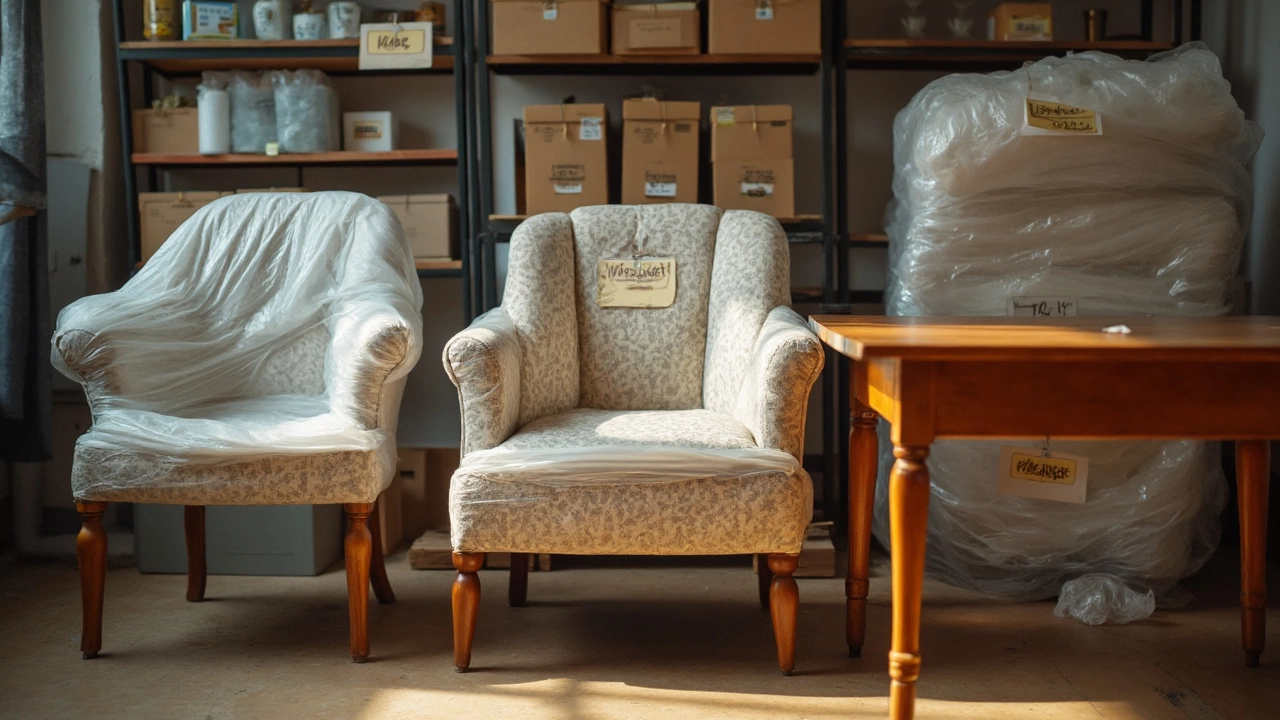
How to Wrap Furniture the Right Way
Getting your furniture storage game right can save you from a lot of headaches. Wrapping the right way doesn’t just protect against dings and dust; it keeps your stuff looking like new. Here’s how to use plastic wrap so it helps—not hurts—your furniture.
- Clean Before You Wrap: Always wipe down surfaces and let them dry. Dust and moisture trapped under the wrap can cause scratches or mold, especially on wood and leather.
- Disassemble When Possible: Take apart tables, beds, or shelving if they’re designed for it. Smaller pieces are easier to wrap and less likely to get damaged.
- Pad First, Wrap Second: For delicate finishes (like polished wood or leather), use moving blankets or bubble wrap first. This layer protects your furniture from stickiness and helps stop surface damage.
- No Plastic Direct on Paint or Leather: Plastic wrap can trap heat or off-gas, causing paint to peel or leather to sweat and warp. Always put a breathable lining (like cloth or kraft paper) on these surfaces before wrapping.
- Don’t Overwrap: One or two layers of plastic wrap does the job. Thick wrapping can hold in too much moisture and heat, upping the risk for damage.
- Seal Smart—But Not Airtight: Leave small gaps or pokes in the wrap for airflow if the piece will sit in storage for months. This stops mold and musty smells.
Here’s a handy table showing which materials need extra prep before you pull out the plastic wrap:
| Furniture Type | Clean First | Padding Needed | Breathable Layer |
|---|---|---|---|
| Wood | Yes | Yes | Yes |
| Leather | Yes | Yes | Yes |
| Upholstered | Recommended | Yes | No |
| Metal | Yes | No | No |
| Plastic | Yes | No | No |
One last tip—label each wrapped item or bundle with what it is and which side is up. This makes unwrapping and setting up later way smoother. Follow these steps and your furniture will survive the move or long-term storage in great shape, with no ugly surprises.
Alternatives to Plastic Wrap
If you’re worried that plastic wrap might mess up your furniture, you’ve got other solid options. A lot of people go old-school and just use moving blankets. They’re thick, reusable, and keep furniture safe from bumps and dust—no sticky side effects. Even better, they let furniture breathe, which stops moisture build-up that can lead to mold.
Another easy choice: stretch fabric furniture covers. These are like giant, soft socks for your stuff. Super helpful for leather and wood pieces because they won’t trap moisture, and there’s zero chance of finish damage. If you’re storing chairs, sofas, or tables, these covers fit snug without sticking to anything.
Bubble wrap sounds bulky but is great for protecting delicate bits and sharp corners—just put a layer between the furniture and whatever is holding it in place. If you want to skip plastic altogether, thick cotton sheets or quilts work surprisingly well, especially for short-term storage.
- Moving blankets: Biggest plus is reusability. Just toss them in the wash and use them again next time you need to move or store furniture.
- Fabric covers: Look for covers made for sofas, love seats, and armchairs. They’re usually affordable and you don’t have to deal with annoying static like plastic wrap.
- Bubble wrap: Stick to wrapping knobs, handles, and glass—skip wrapping the whole item to avoid heat or moisture issues.
- Cotton sheets or quilts: These can pad your furniture and let air flow, stopping that trapped-damp smell.
If you care about the environment, watch for eco-friendly options popping up too. Some companies now offer biodegradable wraps or even reusable padded storage bags—these are good if you're moving often or care a lot about cutting down on trash.
| Alternative | Reusable? | Best For | Downsides |
|---|---|---|---|
| Moving Blankets | Yes | All furniture | Bigger stuff can get pricey |
| Fabric Covers | Yes | Upholstered & leather | Need right size |
| Bubble Wrap | No (usually) | Knobs, glass | Plastic waste |
| Cotton Sheets | Yes | Anything | Less padding |
Think about how long your items will be packed up. For quick moves, an old blanket might be all you need. For months in a humid garage, go with covers that breathe. The right move keeps your furniture clean and safe, without plastic headaches.
Smart Storage Tips for Zero Damage
If you want to store your stuff and have it come out looking just as good as when it went in, a few simple tweaks make a big difference. Here’s what really keeps furniture storage drama-free.
- Clean First, Always: Even if it feels pointless, scrub your surfaces. Dust and small crumbs trapped under plastic wrap or covers will get ground in and may leave marks or even mold if they get damp.
- Wrap With Layers: Never let plastic touch delicate wood or leather directly. Put down a layer—like a cotton sheet or acid-free paper—before the plastic, so finishes don’t get sticky or sweat under the wrap. Some pro movers swear by this for expensive sofas and tables.
- Watch the Climate: Signs say that 60–80% of storage unit damage comes from moisture. Climate-controlled storage costs extra but pays off with no mildew, no rusty screws, and no warped wood.
- Don’t Overdo It: Too much plastic can seal in humidity. Loosely wrapping instead of mummifying your stuff gives it a chance to breathe, which is crucial if you’ll be storing things for a while.
- Label Everything: The biggest headache is unwrapping random mystery bundles later. Use markers or sticky notes under the plastic so you know what's what without tearing into everything.
| Mistake | What Happens | Quick Fix |
|---|---|---|
| Sealed plastic on leather | Traps moisture, causes mildew or sticky finish | Always use a breathable layer underneath |
| Packing while dirty | Dust or crumbs make scratches, stains, or attract bugs | Clean, let dry, then wrap |
| No climate control | Warped wood, rust, and mold | Opt for climate-controlled storage if possible |
One last pro tip: Put furniture on pallets or tarps, not directly on concrete. Concrete floors get colder and damper than you think, and that extra layer keeps water and pests away. By keeping things simple and smart, you’ll dodge almost every common furniture storage fail out there.
